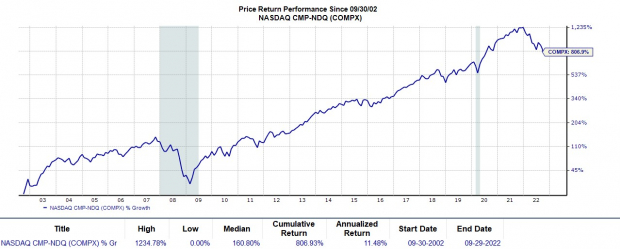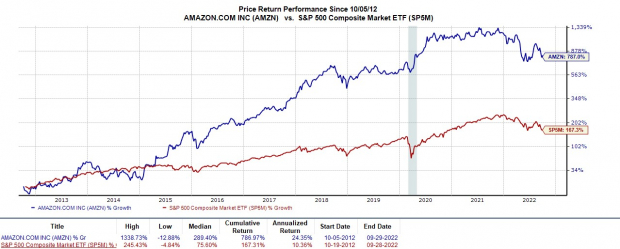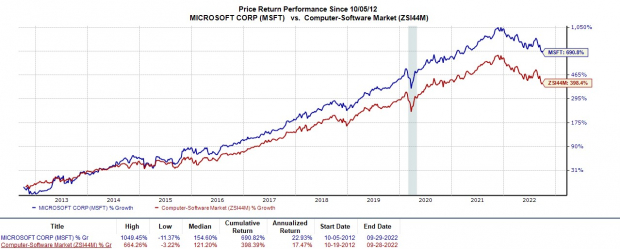Don't Panic, And Look To These 2 Big Tech Stocks After The Selloff

Image: Bigstock
Investors may be concerned as broader markets continue to plummet with economic uncertainty stemming from rising inflation and higher interest rates. Although there may still be risk ahead, investors might want to begin pondering Warren Buffett’s most famous investment strategy; be greedy when others are fearful.
Of course, the other half of this famous quote is to be fearful when others are greedy, but opportunities are starting to brew. In particular, big tech stocks are beginning to present solid opportunities for patient investors to start building positions.
Buffet’s mentor Benjamin Graham is famous for insisting that investors look at large declines in the stock market as a discount or sale rather than panic.

Image Source: Zacks Investment Research
As we can see from the chart above, the Nasdaq is up +800% over the last 20 years. There is a clear path upward after the financial crisis in 2008. Surely investors were panicking during these times, but it was symbolic of the discount that Graham often referred to.
Let’s take a look at two quality tech stocks that have a chance to go back to their previous highs once macroeconomic conditions stabilize.
Amazon (AMZN - Free Report)
After a recent 20-for-1 stock split, Amazon has been trading at its most affordable level in over a decade in terms of the face value of its stock price. Amazon’s stock had routinely traded over $2,000 a share. Investors can buy the stock for $113 a share, which is also 39% beneath its 52-week highs.
AMZN currently sports a Zacks Rank #3 (Hold), and inflation may continue taking its toll on consumer e-commerce spending. However, Amazon is still a very viable investment for growth. According to Zacks estimates, Amazon’s earnings are expected to drop -93% this year, but fiscal 2023 earnings are expected to rebound and climb an impressive 956% at $2.21 a share.
This is also back to its 2020 levels when the company saw a boost in e-commerce spending during COVID-19. Top line growth is expected as well, with sales set to climb 11% this year and another 15% in FY23 to $602.52 billion.
Amazon’s top line growth from FY21 to FY23 is more than what many of the largest companies make in a year. In comparison, Amazon's sales growth during this time span is larger than Target's (TGT - Free Report) annual sales.
Year-to-date, AMZN is down -32% to underperform the S&P 500’s -24%. However, this is on par with the Nasdaq’s -32% drop. Amazon’s peer group has fallen by 40%. With that being said, AMZN has climbed 138% in the last five years.

Image Source: Zacks Investment Research
Even better, over the last 10 years, AMZN is up a staggering +787%, crushing the benchmark’s +167%. Plus, AMZN has been trading well off its decade-long highs of 8,055.3X and getting closer to the median of 132.6X. Amazon’s price to sales is currently at 2.4X and getting close to the optimum level of less than 2X. The industry average P/S is 1.2X.
However, Amazon’s cloud platform AWS has continued to grow, most recently contributing to $5.72 billion in operating income during the second quarter, up 36% year-over-year. Cloud, along with continued efforts in expanding its streaming services through Amazon Prime, has shown the company can make good use of its $60 billion cash on hand.
The average Zacks Price Target offers 55% upside from Amazon’s current levels.
Microsoft (MSFT - Free Report)
Microsoft is one of the largest broad-based technology providers in the world. Microsoft’s products include operating systems, cross-device productivity applications, server applications, business solution applications, desktop and server management tools, software development tools, and video games.
Microsoft’s growth in the cloud and its savvy acquisitions have helped MSFT maintain its standing as a Computer-Software industry leader. During its fiscal fourth quarter, Microsoft’s Intelligent Cloud revenue climbed 20% to $20.9 billion. This was largely due to its public cloud computing platform Azure.
The growth of Azure along with acquiring LinkedIn and countless others, including the possible future acquisition of Activision Blizzard, help Microsoft continue growing and innovating through multiple revenue streams.
MSFT is down -30% year-to-date to underperform the S&P 500. This is on par with the Computer-Software Market’s -32% drop. However, over the last five years, Microsoft is up +213%. Even better, over the last decade, MSFT is up an impressive +690% to crush the Computer-Software Market and the benchmark’s +167%.

Image Source: Zacks Investment Research
The stellar 10-year price performance in the chart above may be a reason for investors to be optimistic about this year’s decline in MSFT. The -30% year-to-date drop could very well be a healthy correction for the long-term, and perhaps a chance to start adding positions at a discount.
Microsoft is 33% off its 52-week highs, recently seen trading around $232 a share. MSFT has a forward P/E of 23.5X, which is near the industry average. This is also lower than its decade high of 37.4X and near the median of 23.7X.
According to Zacks estimates, MSFT earnings are expected to rise 9% to $10.09 a share in 2022. Fiscal 2023 earnings are expected to climb another 15%. Microsoft’s sales are projected to be up 11% this year and another 13% in FY23 to $249.93 billion.
Microsoft has also flexed its impressive balance sheet with its most recent $60 billion share repurchase program. Such notable buybacks increase the value of remaining shares for investors with MSFT also boosting its dividend six times in the last five years. MSFT’s current annual dividend yield is a modest 1.04% at $2.48 a share.
MSFT currently lands a Zacks Rank # 3 (Hold) and its Computer-Software Industry is in the bottom 39% of over 250 Zacks Industries. However, the average Zacks Price target offers 39% upside from current levels.
Bottom Line
While it may not be time to be greedy, the decline among big tech stocks is creating what could turn out to be a valuable opportunity for investors. It will be important for investors to stay focused and not panic during downturns.
There may be more downside risks ahead, however this allows time to start building meaningful positions. Stocks like Amazon and Microsoft have greatly rewarded patient investors over the last decade, and after this downcycle, their stellar performances could continue.
More By This Author:
3 Top-Ranked Small-Caps Shrugging Off Market Woes
Bear of the Day: Mohawk Industries
Bull Of The Day: Cracker Barrel Old Country Store
Disclosure: Zacks.com contains statements and statistics that have been obtained from sources believed to be reliable but are not guaranteed as to accuracy or completeness. References to any specific ...
more


